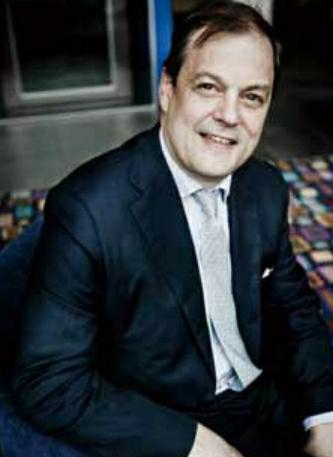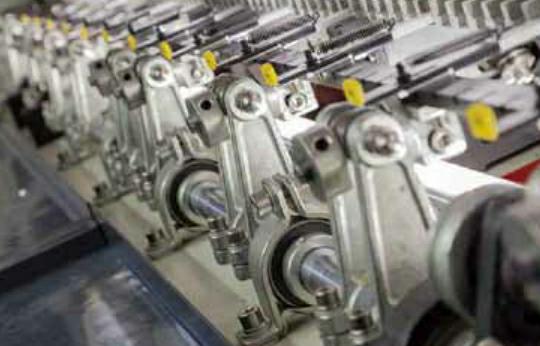CEMATEX:Greater focus on sustainability
By+Zhao+Zihan
CEMATEX (Comité Européen des Constructeurs de Machines Textiles) is an organization comprising 9 national European textile machinery associations in the free market economy.
CEMATEX is the owner of ITMA and one role is to preserve the role of ITMA as the worlds premier exhibition of textile machinery.
At the upcoming ITMA in Milano this November, the reporter of China Textile had an opportunity to have an interview with Mr. Charles Beauduin, President of CEMATEX.
Q: At present, Chinese textile enterprises have largely slowed down their demand for textile machinery products compared to several years ago owing to the economic slowdown in China. In this case, does it have any impacts to the production and sales of textile equipment in Europe? And to what extent?
Beauduin: The Chinese textile industry like its counterparts around the world is facing challenges. The economic slowdown has impacted all businesses. Textile machinery sales for all manufacturers, not only the Europeans, have suffered. As a result, many European machinery manufacturers are exploring new emerging markets, such as Central Asia and Africa. Other important markets for European machinery manufacturers are India, Turkey and the US.
Q: Today, many developing countries such as India and Vietnam are enjoying rapid development of textile industry, and their demand for textile machinery in Europe is to grow. How about the growth? The textile industry in those markets is growing strong, and does it mean that the European textile equipment sales center will move out from China?
Beauduin: India and Vietnam are considered the brighter sparks as their textile industry is faring better compared with many other countries. China is still a dominant player in the global textile and garment industry, despite the slowdown. Hence, it remains an important market for European machinery manufacturers. The importance of China is underscored by the continued staging of the ITMA ASIA+CITME exhibition series in Shanghai which is owned by CEMATEX and other Chinese partners.
Q: What characteristics has European textile machinery sale presented till now? For example, which equipment is more popular with the customers, and which nations and regions are the main sales destinations?
Beauduin: European textile machinery manufacturers enjoy a strong reputation for high-end technologies as they are always investing in research and product development. Product enhancements and portfolio enlargement are necessary to drive demand. Many of them are gearing up production of machinery for technical textiles manufacturing and those with sustainable features, such as energy and water saving technologies, as they are in demand now. The machinery buyers are mainly from Asia.
Q: Compared with the European textile equipment products, what do you think are the advantages of Chinese textile machinery? What are the gaps of textile equipment in China and how to improve?
Beauduin: Chinese manufacturers are strong competitors in the domestic and global markets due to cost advantages arising from economies of scale, as well as their large pool of low-cost labour. They are increasing their presence in developed markets and growing their businesses throughout the value chain. They would need to add to their competitive strengths by building skills that go beyond cost leadership, such as developing cutting-edge capabilities.
Q: How do you regard the continuously increasing number of Chinese textile enterprises to the overseas exhibitions?
Beauduin: Established exhibitions, such as ITMA, attract the entire global industry. As many new innovations and products are launched at these platforms, they are the best places to source new machinery, as well as keep abreast of the latest industry trends and developments. Very often, they are complemented by conferences which further increase participantsknowledge and networking opportunities.
Chinese textile enterprises are becoming more discerning. Hence they are visiting major overseas exhibitions to keep themselves attuned to global trends and to source for new ideas and technologies to sharpen their competitiveness.
Q: According to your prediction, is China still the first choice for the European textile machinery enterprises to build overseas factories in the next few years? And why?
Beauduin: Based on International Textile Manufacturers Federation reports, Asia remains the main importer of textile machinery from Europe, with China being the largest buyer. As mentioned earlier, China is still an important market. The decision to build overseas factories will be dictated by the each manufacturers business strategy and plan for China and the Asian market.
Q: As far as you know, what new equipment and technology will be unveiled at the show? And what are the new features and trends of the exhibits?
Beauduin: As there is greater focus on sustainability in recent years, responsible sourcing and eco-friendly technologies will be a common trend seen at this years exhibition. These innovations can be found throughout the 19 chapters featured in the exhibition.
Technological innovations can go a long way in mitigating the main environmental issues faced by the textile and garment industry, particularly in the dyeing and finishing, chemicals and colourants, and fibre and yarn sectors. Among the examples are innovative waterless dyeing technology and advanced dyestuffs with new formulations requiring less water, and even dyes derived from agricultural waste products.
Technical textiles is a very exciting growth segment. Increasingly, the possibilities for technical textiles are expanding beyond the traditional coated fabrics and protective clothing, and we can expect to see some of the latest technologies in various product sectors at ITMA 2015.
Digital printing technologies will also be more prominently featured as the product index has been expanded to feature printing as a separate chapter. The fibre & yarn sector has also been expanded to include a new sub-chapter on recycled fibres and yarns, in order to cater to the evergrowing segment and interest in sustainable raw materials.

